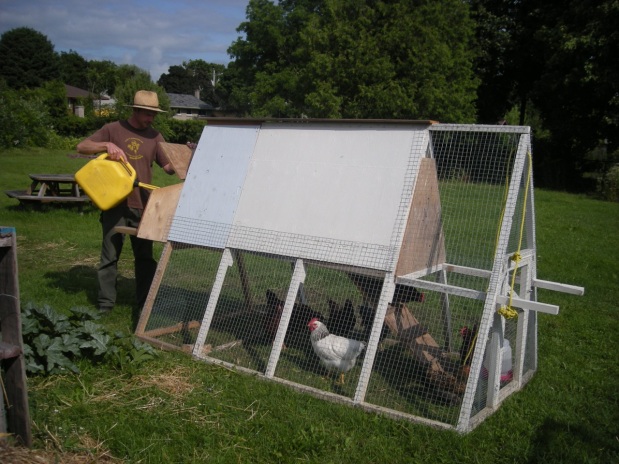Chicken tractor? You might be thinking to yourself. Maybe you have an image of a chicken driving a tractor or a tractor powered by chickens?
The latter is kind of the case. No diesel required.
It is a mobile coop and run combined. The idea is that you can move it daily (or as often as you like) and the chickens will trim the grass and fertilize the ground at the same time!
My chicken tractor is one that someone was throwing out and wasn’t very well constructed in the first place. I had to replace all of the wire. Plus I lengthened it and custom built proper nesting boxes on the back. It ended up taking me so long, that I probably would have saved some time to just let it get tossed and build something from scratch.
However, the material was still almost brand new, so, I am happy to have saved that. As well, it gives me a good idea of how to build my next one when this one rots out in a few years.
There are a lot of different designs for chicken tractors out there. They are a bit easier to design and work better with meat birds vs. laying hens. As hens need nesting boxes and a proper place to sleep. There are lots of good designs for chicken tractors for meat birds, but none that I am too keen on for laying hens. They are either too heavy or too small or overly complicated to build or a combination.
I am working on a improved design in my head for a tractor that is suitable for 7-8 hens and light enough to easily move with one person.
This one pictured is a common A-frame type tractor with a protected loft area for the hens to perch, nest and hang the feeder and a more spacious open floored area below for them to scratch. The floor in the loft is just hardware cloth on the cross supports. This may seem cruel, but the hens don’t seem to mind and they are mostly on the grass anyway. The mesh allows their poop to fall on the ground, making the chickens very little work in the warmer months. This type of coop isn’t suitable for year round use in this part of Canada anyway.
I originally used a 1/2 inch hardware cloth for the floor. Thinking that this would be nicer for the hens to walk on. It may have been, but the holes in the mesh weren’t large enough for their poop to fall through all the time. The area where they were sleeping was getting totally clogged and gross with chicken poop.
This was no good and I couldn’t repair it with the hens in there. So, we just dealt with it for a few months and I changed the floor to a 1 inch hardware cloth (same as I used on the sides) and this works great.
Here’s the new cloth installed.
And this is the floor after a few weeks use. The Plymouth Barred Rock doesn’t seem to mind the floor and no poop clogging the holes!
The other issue I had with my design is that I made the doors on the side open up. My thoughts were that this would be easier to keep the hens from trying to hop out when refilling the feeder, etc. However, in reality, the hens were always kind of surprised to see me and not really interested in trying to escape. This also meant that I had to hold the door open with my head, which wasn’t very comfortable.
In most A-frame designs I had seen, the doors folded down and I understood why. So, I changed mine to fold down and it is so much better.






